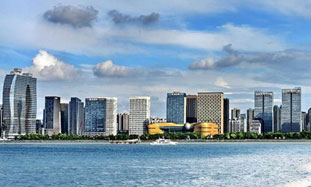Museums along Grand Canal band together for cultural protection and promotion

The Beijing-Hangzhou Grand Canal starts in Beijing and ends in Hangzhou, capital of East China's Zhejiang province. [Photo provided to ezhejiang.gov.cn]
Nearly 30 museums in five cities along the Beijing-Hangzhou Grand Canal in East China's Zhejiang province, announced the formation of an alliance on May 15 to better protect canal culture and tell its stories.
Hangzhou, Ningbo, Jiaxing, Huzhou and Shaoxing have been nourished by the culture that has formed along the world's longest man-made waterway over the past millennium. Museums in these cities have decided to join hands with the Grand Jing-Hang Canal Museum to spread that culture to a wider audience via the newly established alliance.
The alliance is expected to improve the protection and management of canal-related relics, exploit more cultural resources, organize exhibitions and exchange activities to better tell stories of the Grand Canal, and make itself a new platform for the display of canal culture.
The Beijing-Hangzhou Grand Canal starts in Beijing and ends in Hangzhou, passing through the municipality of Tianjin and the provinces of Hebei, Shandong, Jiangsu and Zhejiang. It links China's two longest rivers, the Yellow River and the Yangtze, and has a length of 1,794 kilometers.
Its Zhejiang section, with a 683-kilometer relic waterway, is the most representative part of canal culture. Along the canal waterway in Zhejiang, there are 107 important heritage sites under state protection and five national historical and cultural cities.
Zhejiang is abundant in museum resources. There are more than 380 museums in the East China province and, in 2018, these museums organized over 2,000 exhibitions.

 Print
Print Mail
Mail
 20 Cultural Symbols
20 Cultural Symbols Why Zhejiang
Why Zhejiang Experiencing high-tech products at WIC
Experiencing high-tech products at WIC Zhejiang Release
Zhejiang Release Zhejiang News
Zhejiang News